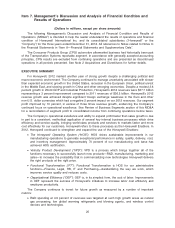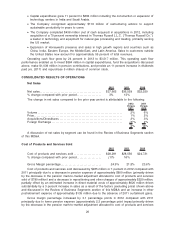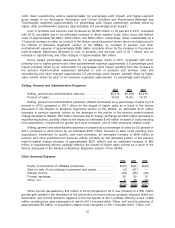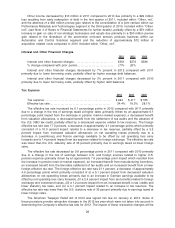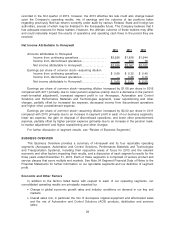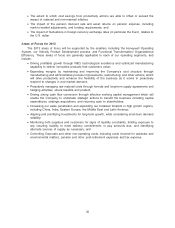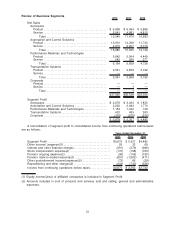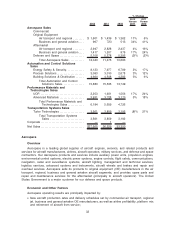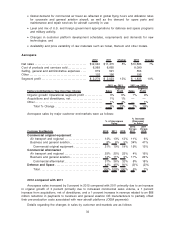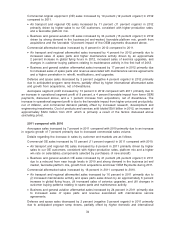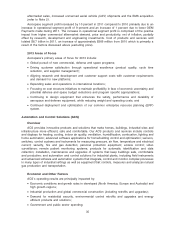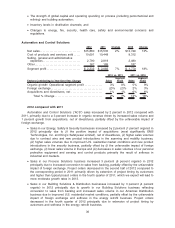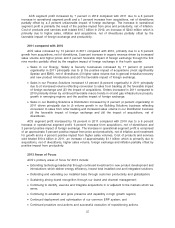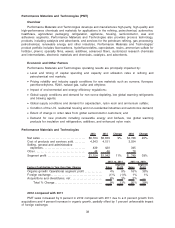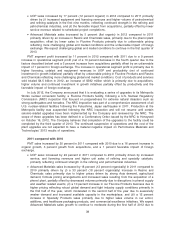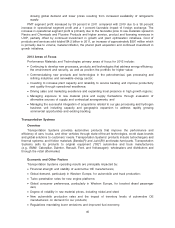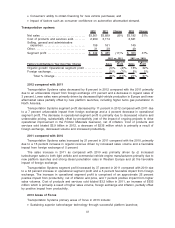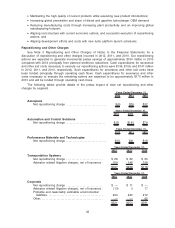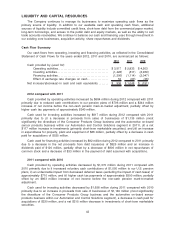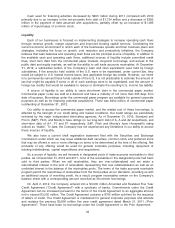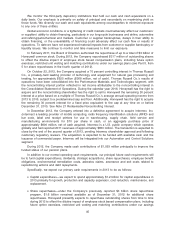Honeywell 2012 Annual Report Download - page 44
Download and view the complete annual report
Please find page 44 of the 2012 Honeywell annual report below. You can navigate through the pages in the report by either clicking on the pages listed below, or by using the keyword search tool below to find specific information within the annual report.aftermarket sales, increased unmanned aerial vehicle (UAV) shipments and the EMS acquisition
(refer to Note 2).
Aerospace segment profit increased by 10 percent in 2011 compared to 2010 primarily due to an
increase in operational segment profit of 9 percent and an increase of 1 percent due to lower OEM
Payments made during 2011. The increase in operational segment profit is comprised of the positive
impact from higher commercial aftermarket demand, price and productivity, net of inflation, partially
offset by research, development and engineering investments. Cost of products and services sold
totaled $8.7 billion in 2011, an increase of approximately $566 million from 2010 which is primarily a
result of the factors discussed above (excluding price).
2013 Areas of Focus
Aerospace’s primary areas of focus for 2013 include:
•Global pursuit of new commercial, defense and space programs;
•Driving customer satisfaction through operational excellence (product quality, cycle time
reduction, and supplier management);
•Aligning research and development and customer support costs with customer requirements
and demand for new platforms;
•Expanding sales and operations in international locations;
•Focusing on cost structure initiatives to maintain profitability in face of economic uncertainty and
potential defense and space budget reductions and program specific appropriations;
•Continuing to design equipment that enhances the safety, performance and durability of
aerospace and defense equipment, while reducing weight and operating costs; and
•Continued deployment and optimization of our common enterprise resource planning (ERP)
system.
Automation and Control Solutions (ACS)
Overview
ACS provides innovative products and solutions that make homes, buildings, industrial sites and
infrastructure more efficient, safe and comfortable. Our ACS products and services include controls
and displays for heating, cooling, indoor air quality, ventilation, humidification, combustion, lighting and
home automation; advanced software applications for home/building control and optimization; sensors,
switches, control systems and instruments for measuring pressure, air flow, temperature and electrical
current; security, fire and gas detection; personal protection equipment; access control; video
surveillance; remote patient monitoring systems; products for automatic identification and data
collection; installation, maintenance and upgrades of systems that keep buildings safe, comfortable
and productive; and automation and control solutions for industrial plants, including field instruments
and advanced software and automation systems that integrate, control and monitor complex processes
in many types of industrial settings as well as equipment that controls, measures and analyzes natural
gas production and transportation.
Economic and Other Factors
ACS’s operating results are principally impacted by:
•Economic conditions and growth rates in developed (North America, Europe and Australia) and
high growth regions;
•Industrial production and global commercial construction (including retrofits and upgrades);
•Demand for residential security, environmental control retrofits and upgrades and energy
efficient products and solutions;
•Government and public sector spending;
35


